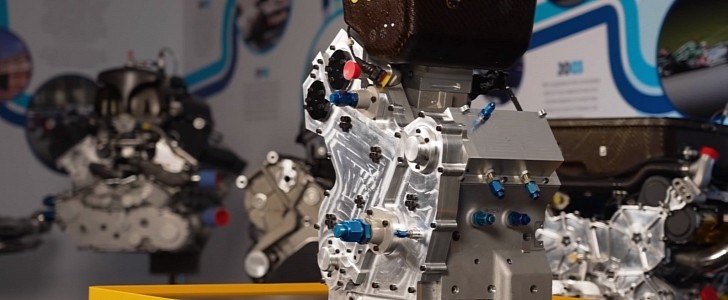Ever wonder what the smallest engine developed by Cosworth looks like? Well, before thinking about inline-four-cylinder units, you should know that they got even smaller than three cylinders. Back in 1998, Cosworth used a single-cylinder engine as a starting point for the development of other motors.
The unit in question only had a displacement of 300 cc (ca. 18.3 cui) but developed 90 horsepower in naturally aspirated form. Moreover, the unit was capable of reaching 20,000 rpm, which is as impressive today as it was 23 years ago. There was no production engine developed based on this unit, though.
Instead, it was a mule for technology that ended up on the TJ engine series, which were employed in Formula 1 starting with the 2003 season, up until 2006. Just like other companies, Cosworth decided to test new ideas on a single-cylinder engine before building things to a larger scale. This mule was turned into a V10 with similar characteristics.
Ferrari used to employ a single-cylinder engine that had a 290-cc (17.69 cui) displacement to develop its V12 engines back in the early 1990s. The four-valve unit had a maximum output of 60 horsepower, which is remarkable from a naturally aspirated unit of that period. Just like the Cosworth single-cylinder unit that came after it, Ferrari did not develop the single-cylinder into a production engine for other uses.
Today, naturally aspirated motors are becoming rare in production vehicles, but they are still found under the hoods of some modern vehicles. Before imagining what the single-cylinder unit would work at 20,000 rpm and picture it on a motorcycle of some sort, you should know that its sound was not fantastic, while vibrations and balance would be issues.
As the video made by Drivetribe will explain, engines like these are used for bench tests, instead of production vehicles. The goal is to have the smallest possible form of an engine, working within parameters, to see how it would react in certain situations.
Instead, it was a mule for technology that ended up on the TJ engine series, which were employed in Formula 1 starting with the 2003 season, up until 2006. Just like other companies, Cosworth decided to test new ideas on a single-cylinder engine before building things to a larger scale. This mule was turned into a V10 with similar characteristics.
Ferrari used to employ a single-cylinder engine that had a 290-cc (17.69 cui) displacement to develop its V12 engines back in the early 1990s. The four-valve unit had a maximum output of 60 horsepower, which is remarkable from a naturally aspirated unit of that period. Just like the Cosworth single-cylinder unit that came after it, Ferrari did not develop the single-cylinder into a production engine for other uses.
Today, naturally aspirated motors are becoming rare in production vehicles, but they are still found under the hoods of some modern vehicles. Before imagining what the single-cylinder unit would work at 20,000 rpm and picture it on a motorcycle of some sort, you should know that its sound was not fantastic, while vibrations and balance would be issues.
As the video made by Drivetribe will explain, engines like these are used for bench tests, instead of production vehicles. The goal is to have the smallest possible form of an engine, working within parameters, to see how it would react in certain situations.







